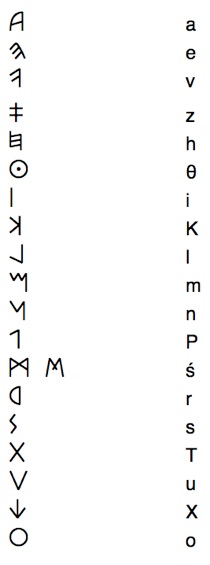An insatiable appetite for ancient and modern tongues


Overview. Gaulish was a Continental Celtic language spoken in a vast area of Europe from the middle of the first millennium BCE until it was driven out by the Roman conquest. It was, probably related to the Insular Brythonic languages (Welsh, Breton, and Cornish).
Classification. Indo-European, Celtic, Continental Celtic, P-Celtic. According to one hypothesis, Celtic languages are divided into P-Celtic and Q-Celtic. P-Celtic links the Brythonic insular languages (Welsh, Cornish, Breton) with continental Gaulish. Q-Celtic links the Goidelic insular languages (Irish, Scottish Gaelic, Manx) with continental Hispano-Celtic. In P-languages the Proto-Celtic labiovelar *kʷ became p; in Q-languages it became k.
Distribution and Varieties. Gaulish was spoken in western and central Europe. Two varieties of Gaulish were spoken in northern Italy (Lepontic) and Asia Minor (Galatian).
Status. Extinct. Lepontic is attested from 600 BCE to the end of the millennium. Gaulish proper is attested from the 3rd century BCE to 500 CE.
Main Documents. Gaulish is documented by inscriptions from France and northern Italy, and by names occurring in classical literature. The earliest inscriptions are written in non-Roman scripts.
-
•The Coligny lunisolar calendar that divides the year in two equal parts headed by summer and winter.
-
•A ceramic plate inscribed with the ordinal numbers 1-10 from La Graufesenque (Millau).
-
•Two lead tablets containing magical incantations in Latin cursive script from L'Hospitalet-du-Larzac.
-
•The lead tablet of Chamalières, a curse or incantation in Latin cursive script.
-
•The inscription of Châteaubleau, discovered in 1997, comprising eleven lines on a tile dating, possibly, from 300-350 CE. It may be a marriage contract.
-
•Place names and coin legends.
Phonology
Vowels. Gaulish had five short and five long vowels as well as several diphthongs.
-
• monophthongs (10):

-
• diphthongs (6): ai, au, ei, eu, oi, ou
Consonants. Gaulish had labiovelar consonants but were rare.

Script and Orthography

Lepontic employed a variety of a north Etruscan script. Gaulish proper was inscribed in the Greek Massiliote script prior to the Roman conquest of Gaul, and in the Latin alphabet afterwards. In the Lepontic script, shown here, neither the voicing of stops nor vowel length was noted; it had 19 signs.
Morphology
-
Nominal. Nouns, adjectives and pronouns were inflected for gender, number and case.
-
-
•gender: masculine, neuter, feminine.
-
•number: singular, plural. A dual number might have existed as well.
-
•case: nominative, vocative, accusative, instrumental, genitive, dative, locative.
-
Declensional endings vary according to the final sound of the stems. The most common stems are those ending in ā and o. There are also other vowel-ending stems (in i and u) and stems ending in a consonant.
-
•pronouns: only few personal pronouns are attested, most of them clitic accusative forms (1st. sg. me, 1st. pl. snj), besides 1st. sg. dative mi. Demonstrative pronouns are so/sā, sosin, sosio. The relative pronoun has been replaced by the uninflected particle yo.
-
•derivation: relied on prefixation, suffixation and compounding.
-
Verbal. Verbs were marked for tense, voice, mood, person and number.
-
•person and number: 1s, 2s, 3s; 1p, 2p, 3p.
-
•tense: present, preterite, future. The preterite forms are the classical Indo-European ones, namely the perfect, sigmatic aorist and imperfect, though the latter has been renewed with the addition of perfect endings.
-
•mood: indicative, subjunctive, imperative. The subjunctive is characterized by the infix -ā-. The imperative is attested in the 2nd person singular taking the form of the bare present stem.
-
•voice: active. Up to now there is no clear evidence of middle or passive voice.
-
•non-finite forms: Gaulish did not have infinitives but used nominalized verbs instead. The present active participle, and past passive participle are attested. The former, ends in -nt. The latter, ending in to/tā, is the most common.
Syntax
Gaulish word order is predominantly Subject-Verb-Object though others have been found. Subject pronouns may be dropped. It is mainly head-initial: adjectives and genitives follow their head nouns. Adjectives agree with their nouns in case, number, and gender; subject and verb agree in person and number. Subordinate clauses follow main clauses. It uses prepositions.
Lexicon. Except for proper names, there are few foreign words in early Gaulish. In later periods, Latin and, to a lesser extent, Greek loans are commonplace.
Basic Vocabulary. We give a list of Gaulish ordinal numbers because the cardinals are barely attested.
first: cintuxos
second: allos
third: tritios
fourth: petuarios
fifth: pinpetos
sixth: suexos
seventh: sextametos
eighth: oxtumetos
ninth: nametos
tenth: decametos
summer: samon
winter: giamon
king: rix
bull: tarvos
sea: more
-
© 2013 Alejandro Gutman and Beatriz Avanzati
Further Reading
-
-'Continental Celtic'. J. F. Eska. In The Ancient Languages of Europe, 165-188. R. D. Woodard (ed). Cambridge University Press (2008).
-
-La Langue Gauloise. Description linguistique, commentaire d’inscriptions choisies. P-Y. Lambert. Errance (2002).
-
-'Transalpine Celtic'. J. F. Eska & D. E. Evans. In The Celtic Languages, 37-42. M. J. Ball & N. Müller (eds). Routledge (2009).
Gaulish

Address comments and questions to: gutman37@yahoo.com
MAIN LANGUAGE FAMILIES
LANGUAGE AREAS
Languages of Ethiopia & Eritrea
LANGUAGES by COUNTRY
LANGUAGE MAPS
-
• America
-
• Asia
-
Countries & Regions
-
-
Families
-
• Europe
-
• Oceania